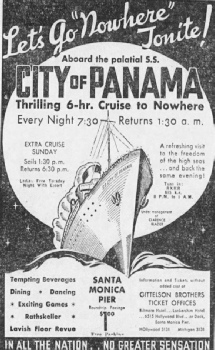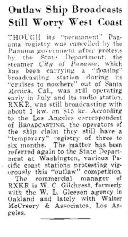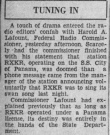© 2014-


RXKR - History (2)
Understandably a ffected stations immediately lodged complaints with the Federal Radio Commission, but like many governments and official bodies over thirty years later, that agency was initially unwilling or unable to stop the activities of the offshore broadcaster. As the result of no action being taken on their behalf by the Federal Radio Commission some legal stations made direct contact with RXKR's backers, requesting that the offshore station move its transmissions from the 815kHz frequency.
ffected stations immediately lodged complaints with the Federal Radio Commission, but like many governments and official bodies over thirty years later, that agency was initially unwilling or unable to stop the activities of the offshore broadcaster. As the result of no action being taken on their behalf by the Federal Radio Commission some legal stations made direct contact with RXKR's backers, requesting that the offshore station move its transmissions from the 815kHz frequency.
Amazingly the response from RXKR's management to these requests was that they would be "willing to accept $5,000 or $10,000 as compensation for their troubles if they are requested to operate on other frequencies."
In addition, the RXKR management were reported to be so pleased with the station’s results that they were planning a voyage along the entire Pacific and Atlantic coasts. The US State Department told Panama they feared the development of a situation with offshore broadcasters moving from place to place and demanding payment from legitimate broadcasting stations under penalty of disrupting their service.
In June 1933 the State Department, again requested that the Panamanian Government revoke both the broadcasting licence for RXKR and the registration of the station's vessel, City of Panama. This time the Panamanian Government's attitude was more positive. They were now fully aware that their 'tourism promotion' vessel and radio station were being wholly misused by the unscrupulous operators and agreed to the US Government request. On 16th June 1933 Pa namanian President Arias requested his Secretary of The Treasury to cancel the City of Panama's registration. The cancellation was announced in the Panama press on 28th June, but three weeks later RXKR was still on the air and the Panamanian Consul in Los Angeles claimed that he had received no notice of cancellation.
namanian President Arias requested his Secretary of The Treasury to cancel the City of Panama's registration. The cancellation was announced in the Panama press on 28th June, but three weeks later RXKR was still on the air and the Panamanian Consul in Los Angeles claimed that he had received no notice of cancellation.
Meanwhile, both the US and Panamanian Governments discussed what action, if any, they could take to silence the now un-
However, there may be a slightly different version of events leading to the end of the City of Panama’s role as a speakeasy. An article in the Los Angeles Times of 8th September 1933 (see News Stand, left) reported that two of the City of Panama’s officers had been arrested following the violent death of a passenger on board during one of the ship’s ‘cruises to nowhere’. No mention is made in the report as to whether RXKR was still broadcasting from the ship, so earlier statements from the station’s management about voluntary closure may have been correct.
The US Government's concern about RXKR was that if no action had been taken to silence the station then a fleet of similar offshore broadcasters would soon anchor off both the east and west coasts, causing interference to legal stations' transmissions. More seriously, as had been graphically demonstrated by the response from RXKR to requests for it to change frequency, an ugly situation could have quickly developed if other offshore broadcasters chose to behave in the same irresponsible manner and engage in similar extortion demands.
The action taken against this early offshore station and the demonstration of just what a threat it had posed to the established broadcasting system also helped shape future United States broadcasting laws, particularly those designed to prevent unauthorised transmissions. The impact of those laws became evident over half a century later when action was taken by the US authorities, this time rather more quickly than in 1933, to silence further offshore stations or even prevent ships involved with such projects leaving port.


Click on picture to enlarge

Advert for City of Panama ‘Cruise to Nowhere’ Los Angeles Times, 16th August 1933
Click to enlarge

History
Key Dates
Ship and Location
Technical
Staff




Broadcasting Magazine
15th July 1933

Los Angeles Times
8th September 1933

Los Angeles Times
25th July 1933
San Francisco Examiner
2nd July 1933
Click to enlarge
Programmes


Thanks to Mike Barraclough for allowing us to use the contemporary American press cuttings he researched about RXKR

Back to RXKR


Back to America Gallery